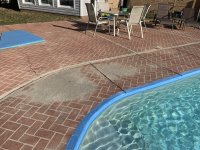Is it viable to lay flagstone on top of concrete?
Our pool (and it’s deck) have been around for at least 35 years. We are planning on selling the house within the next year and i think updating the pool would serve us well.
We haven’t sealed the deck as we should have so we now have some small cracks forming where water has gotten in. (I do not believe this is a structural or settling issue.)
Rather than rip up 300sf of concrete, and likely create an issue because we can’t tell where the pool coping ends and the deck begins, can flagstone be laid on top of the concrete?
I’m guessing we’d first need to repair cracks and reseal the concrete, then put down a layer of sand (how thick?) and compact it.
While most would use mortar between the stones, I’m wondering why not use sand and compact it between them? Seems this would allow for some shifting without cracks. Would probably have to add to and recompact every so often, but that doesn’t seem to be a dealbreaker to me.
Bad idea? Things to watch out for? What does the tribe say?
Our pool (and it’s deck) have been around for at least 35 years. We are planning on selling the house within the next year and i think updating the pool would serve us well.
We haven’t sealed the deck as we should have so we now have some small cracks forming where water has gotten in. (I do not believe this is a structural or settling issue.)

Rather than rip up 300sf of concrete, and likely create an issue because we can’t tell where the pool coping ends and the deck begins, can flagstone be laid on top of the concrete?
I’m guessing we’d first need to repair cracks and reseal the concrete, then put down a layer of sand (how thick?) and compact it.
While most would use mortar between the stones, I’m wondering why not use sand and compact it between them? Seems this would allow for some shifting without cracks. Would probably have to add to and recompact every so often, but that doesn’t seem to be a dealbreaker to me.
Bad idea? Things to watch out for? What does the tribe say?



